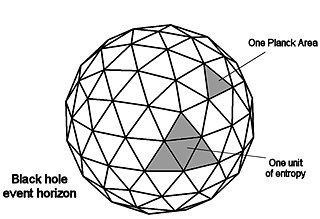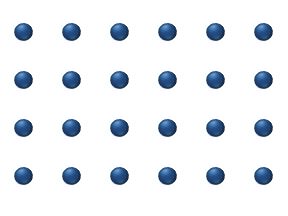
In physics, black hole thermodynamics is the area of study that seeks to reconcile the laws of thermodynamics with the existence of black hole event horizons. As the study of the statistical mechanics of black-body radiation led to the development of the theory of quantum mechanics, the effort to understand the statistical mechanics of black holes has had a deep impact upon the understanding of quantum gravity, leading to the formulation of the holographic principle.
A conformal field theory (CFT) is a quantum field theory that is invariant under conformal transformations. In two dimensions, there is an infinite-dimensional algebra of local conformal transformations, and conformal field theories can sometimes be exactly solved or classified.
In mathematics, the Dedekind eta function, named after Richard Dedekind, is a modular form of weight 1/2 and is a function defined on the upper half-plane of complex numbers, where the imaginary part is positive. It also occurs in bosonic string theory.

Erik Peter Verlinde is a Dutch theoretical physicist and string theorist. He is the identical twin brother of physicist Herman Verlinde. The Verlinde formula, which is important in conformal field theory and topological field theory, is named after him. His research deals with string theory, gravity, black holes and cosmology. Currently, he works at the Institute for Theoretical Physics at the University of Amsterdam.
In physics, the Brans–Dicke theory of gravitation is a competitor to Einstein's general theory of relativity. It is an example of a scalar–tensor theory, a gravitational theory in which the gravitational interaction is mediated by a scalar field as well as the tensor field of general relativity. The gravitational constant is not presumed to be constant but instead is replaced by a scalar field which can vary from place to place and with time.

In physics, the Bekenstein bound is an upper limit on the thermodynamic entropy S, or Shannon entropy H, that can be contained within a given finite region of space which has a finite amount of energy—or conversely, the maximal amount of information required to perfectly describe a given physical system down to the quantum level. It implies that the information of a physical system, or the information necessary to perfectly describe that system, must be finite if the region of space and the energy are finite. In computer science this implies that non-finite models such as Turing machines are not realizable as finite devices.
In general relativity, the Gibbons–Hawking–York boundary term is a term that needs to be added to the Einstein–Hilbert action when the underlying spacetime manifold has a boundary.
In theoretical physics, massive gravity is a theory of gravity that modifies general relativity by endowing the graviton with a nonzero mass. In the classical theory, this means that gravitational waves obey a massive wave equation and hence travel at speeds below the speed of light.
Quantum speed limit theorems are quantum mechanics theorems concerning the orthogonalization interval, the minimum time for a quantum system to evolve between two orthogonal states, also known as the quantum speed limit.
In quantum computing, and more specifically in superconducting quantum computing, the phase qubit is a superconducting device based on the superconductor–insulator–superconductor (SIS) Josephson junction, designed to operate as a quantum bit, or qubit.

Entropic gravity, also known as emergent gravity, is a theory in modern physics that describes gravity as an entropic force—a force with macro-scale homogeneity but which is subject to quantum-level disorder—and not a fundamental interaction. The theory, based on string theory, black hole physics, and quantum information theory, describes gravity as an emergent phenomenon that springs from the quantum entanglement of small bits of spacetime information. As such, entropic gravity is said to abide by the second law of thermodynamics under which the entropy of a physical system tends to increase over time.

In statistical mechanics, thermal fluctuations are random deviations of an atomic system from its average state, that occur in a system at equilibrium. All thermal fluctuations become larger and more frequent as the temperature increases, and likewise they decrease as temperature approaches absolute zero.
In physics, Liouville field theory is a two-dimensional conformal field theory whose classical equation of motion is a generalization of Liouville's equation.
In mathematical physics, the Wu–Sprung potential, named after Hua Wu and Donald Sprung, is a potential function in one dimension inside a Hamiltonian with the potential defined by solving a non-linear integral equation defined by the Bohr–Sommerfeld quantization conditions involving the spectral staircase, the energies and the potential .
In general relativity, the Hamilton–Jacobi–Einstein equation (HJEE) or Einstein–Hamilton–Jacobi equation (EHJE) is an equation in the Hamiltonian formulation of geometrodynamics in superspace, cast in the "geometrodynamics era" around the 1960s, by Asher Peres in 1962 and others. It is an attempt to reformulate general relativity in such a way that it resembles quantum theory within a semiclassical approximation, much like the correspondence between quantum mechanics and classical mechanics.
A two-dimensional conformal field theory is a quantum field theory on a Euclidean two-dimensional space, that is invariant under local conformal transformations.
The Ryu–Takayanagi conjecture is a conjecture within holography that posits a quantitative relationship between the entanglement entropy of a conformal field theory and the geometry of an associated anti-de Sitter spacetime. The formula characterizes "holographic screens" in the bulk; that is, it specifies which regions of the bulk geometry are "responsible to particular information in the dual CFT". The conjecture is named after Shinsei Ryu and Tadashi Takayanagi, who jointly published the result in 2006. As a result, the authors were awarded the 2015 New Horizons in Physics Prize for "fundamental ideas about entropy in quantum field theory and quantum gravity". The formula was generalized to a covariant form in 2007.
In two-dimensional conformal field theory, Virasoro conformal blocks are special functions that serve as building blocks of correlation functions. On a given punctured Riemann surface, Virasoro conformal blocks form a particular basis of the space of solutions of the conformal Ward identities. Zero-point blocks on the torus are characters of representations of the Virasoro algebra; four-point blocks on the sphere reduce to hypergeometric functions in special cases, but are in general much more complicated. In two dimensions as in other dimensions, conformal blocks play an essential role in the conformal bootstrap approach to conformal field theory.
A set of networks that satisfies given structural characteristics can be treated as a network ensemble. Brought up by Ginestra Bianconi in 2007, the entropy of a network ensemble measures the level of the order or uncertainty of a network ensemble.
Massless free scalar bosons are a family of two-dimensional conformal field theories, whose symmetry is described by an abelian affine Lie algebra.















